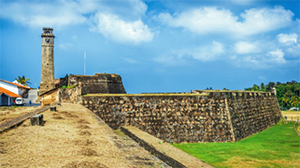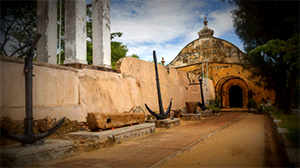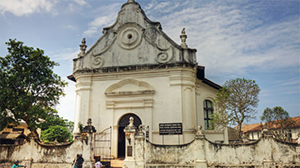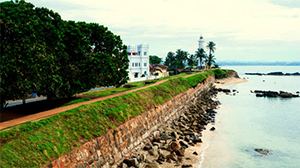The Sri Lankan port of Galle (pronounced Gaul) lies close to the island’s southernmost point, and is Sri Lanka’s fourth largest city. The old Dutch quarter known as ‘The Fort’ is the heart of modern Galle, though somewhat separate from it. It is Sri Lanka’s best-conserved area of colonial architecture.
The Fort has some of the most splendid and intact colonial structures in South East Asia, from 16th century Portuguese to 17th and 18th century Dutch, with some 19th century British buildings.
The area was made an UNESCO World Heritage Site in 1988, and has a quiet, understated charm; it is an old but working village complete with post offices, courts, schools, shops, and religious buildings, several of which have not changed for over a century.
The massive stone walls separate the fortified Sri Lankan colonial town from the bustling modern town of Galle. The Fort is surrounded by coral and small private beaches, easily able to give visitors a couple of pleasurable days of trundling around the atmospheric old streets and walls, enjoying the relaxed pace of life. Here are some of the world's best hotels, spas and food, making it the perfect place to rest and recuperate from the stressful western lifestyle.
| Places in Galle | Description | Gallery |
|---|---|---|
| Galle Fort | Surrounded by the sea on three sides, the Galle Fort is perhaps the most touristy destination in Galle. Built in 1588 by the Portuguese, the fort is a UNESCO World Heritage Site and is so strong that when the Tsunami of 2004 struck the island, the fort remained unscathed. The premises of the fort houses a lighthouse, the Old Dutch Hospital, the Meera Mosque, a gemstone workshop and the ruins of an old Dutch Clock tower. |  Book Now Book Now |
| The National Maritime Museum | Opened to public on May 9, 1992, the National Maritime Museum in Galle is located within the Dutch Warehouse building, which itself was constructed in 1671. The warehouse is a long two-storied building and served as an entrance to the fort. Over the centuries, the building served various purposes including that of an complex that housed government offices. This was one of the few buildings that survived the impact of the 2004 tsunami even though most of the artifacts were lost. It took three years of reconstruction and help from the Netherlands before it was back in business. Today, it exhibits over hundreds of artifacts discovered around the coast of Galle such as maps, naval crafts, barrels, ropes, smoking pipes, sailor shoes and guns retrieved from the Dutch East India company that sank into the the sea in 1659. |  Book Now Book Now |
| The Dutch Reformed Church | Formerly known as Groote Kerk, the church was built in 1755 on the highest point of the Galle fort and is perhaps the oldest Protestant Church in Sri Lanka. The church was renovated by the funds of the Dutch Embassy and inaugurated on November 28, 2004 by the the then President and Dutch Ambassador. |  Book Now Book Now |
| Enjoy the Galle Fort Walk | Enjoy a 90-minute walking tour of the fort, along with author Juliet Coombe (Around the Fort in 80 Lives). The walks introduce you to the lesser known spots of the fort and also come in various fun themes. Its gives you an unforgettable insight into the gardens, architecture, artisans, food and wildlife in and around the fort. |  Book Now Book Now |
To book a tour, please email srilankadrivertours@yahoo.com or nilupul7h@yahoo.com


